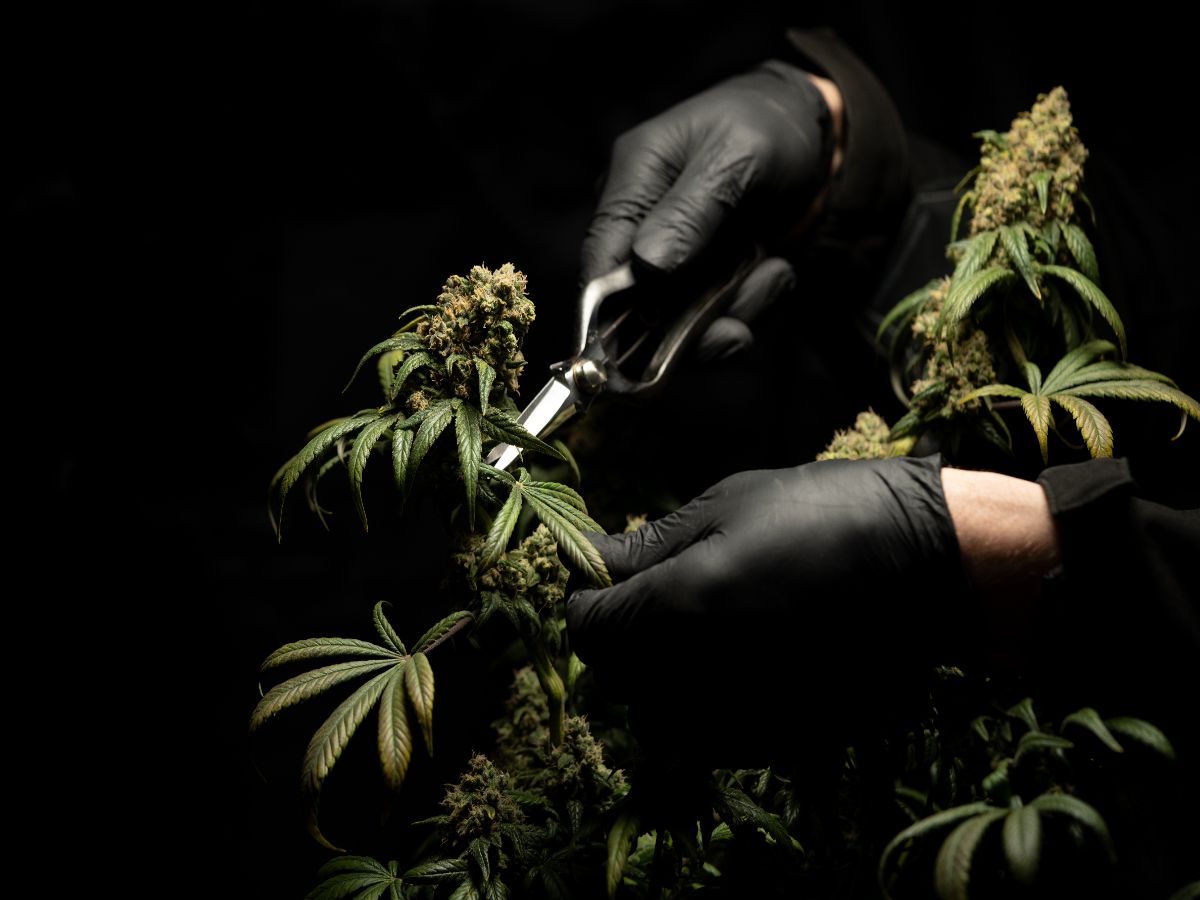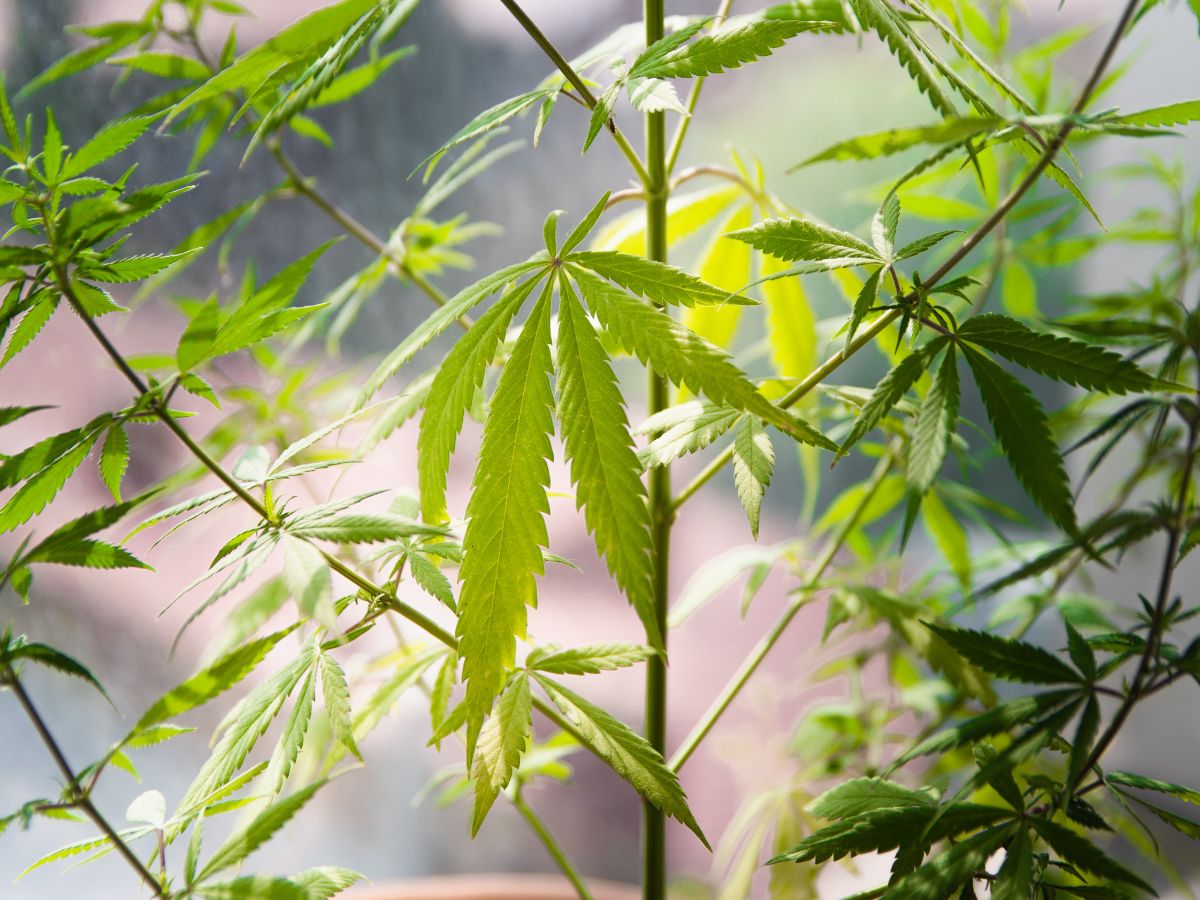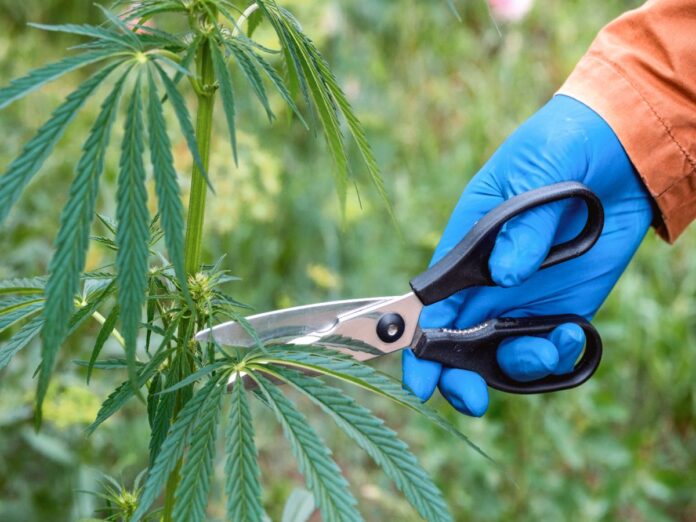If you’re a cannabis gardener, you know that there’s more to cultivating this versatile plant than simply planting the seeds and waiting for it to grow.
In order to achieve optimal results, it’s important to understand various techniques that can enhance the quality and yield of your cannabis plants.
One such technique is defoliation, which involves removing certain leaves from the plant. But when exactly should you defoliate your cannabis? This guide will provide you with all the insights you need to make the right decision, ensuring your plants thrive throughout their growth cycle.
Imagine this: you’ve spent weeks carefully tending to your cannabis plants, providing them with the perfect balance of nutrients, light, and water. As they grow, you marvel at their lush foliage, but the thought of defoliating them seems counterintuitive. After all, won’t removing leaves hinder their photosynthesis and stunt their growth? Well, not quite. The practice of defoliation is a strategic technique employed by experienced cannabis growers to maximize the plant’s potential.
By selectively removing specific leaves, you can redirect the plant’s energy and resources towards more essential areas, such as bud development and overall plant health.
This process helps improve air circulation and light penetration in the lower regions of the plant, reducing the risk of mold, mildew, and pests. When performed correctly and at the right time, defoliation can lead to bigger, denser buds and increased yields.
So, let’s discuss when to defoliate cannabis and discover the optimal timing that will bring your gardening skills to the next level.
When to Defoliate Cannsis During the Vegetative State
During the vegetative stage of cannabis growth, the plant focuses on developing a strong root system and lush foliage. This is the ideal time to start considering defoliation. The key is to wait until your plants have reached a certain level of maturity before you begin removing leaves.
Typically, it’s recommended to wait until your cannabis plants have at least four to six nodes before initiating any defoliation. Nodes are the points where leaves and branches emerge from the main stem. At this stage, your plants will have enough foliage to sustain healthy growth while also allowing for effective defoliation.
In terms of how much foliage you should remove during the vegetative stage, it’s important not to go overboard. Start by selectively removing larger fan leaves that are blocking light from reaching lower parts of the plant. These leaves tend to be older and less productive in terms of photosynthesis.
Remember, the goal is not to completely strip your plants of their leaves but rather create a balance between light penetration and leaf coverage. By carefully removing a few select leaves, you can improve airflow within the canopy and promote better nutrient distribution throughout the plant.
When To Defoliate Cannabis on The Flowering Stage

Defoliate cannabis plants in the flowering stage about two weeks after adjusting the light cycle to 12 hours on and 12 hours off. This timing allows the plants to recover as they’ve just started forming buds. Exercise caution during this stage; focus on eliminating only the larger fan leaves obstructing light to lower buds. Remove yellow or dying leaves, but keep healthy green leaves intact for optimal photosynthesis and energy supply.
After the initial defoliation two weeks into the flowering stage, it’s essential to monitor your plants closely. The goal is to strike a balance between maximizing light penetration and minimizing plant stress. If you notice that the lower bud sites are still not receiving adequate light, you may consider a second round of defoliation. However, this should be done judiciously to avoid stressing the plant, which could lead to reduced yields or other complications.
As the plants move closer to full bloom, around weeks 5-6 of the flowering stage, further defoliation is generally not recommended. At this point, the plant is focusing its energy on bud development, and any additional stress could negatively impact this process. Removing leaves at this late stage could also expose the buds to excessive light, potentially leading to bleaching or reduced potency.
The Purpose of Defoliation
Before diving deeper into when to defoliate cannabis, it’s important to understand why this technique is employed by cannabis growers in the first place.
The primary purpose of defoliation is to optimize plant health and maximize yields. By selectively removing certain leaves, you can redirect the plant’s energy towards more productive areas such as bud development. This process also helps improve air circulation within the canopy, reducing the risk of mold and mildew formation.
In addition to improving airflow, defoliation enhances light penetration throughout the plant. By removing excess foliage that may be blocking light from reaching lower bud sites, you ensure that all parts of your cannabis plants receive adequate light for optimal growth.
Benefits of Defoliation in Cannabis Cultivation
The benefits of defoliation in cannabis cultivation are numerous and can significantly impact your final harvest. Let’s explore some key advantages:
1. Increased Light Penetration: By selectively removing leaves that block light from reaching lower bud sites, you allow for better light distribution throughout your plants’ canopy. This results in improved photosynthesis and overall growth.
2. Enhanced Air Circulation: Removing excess foliage promotes better airflow within the canopy, reducing the risk of mold, mildew, and pest infestations. Good air circulation is crucial for maintaining healthy plants.
3. Better Nutrient Distribution: Defoliation helps ensure that nutrients are evenly distributed throughout the plant. By removing leaves that may be blocking nutrient uptake in certain areas, you encourage balanced growth and development.
4. Increased Bud Size and Density: By redirecting the plant’s energy towards bud development, defoliation can lead to larger, denser buds. This ultimately translates into higher yields and a more satisfying harvest.
Factors to Consider Before Defoliating

While defoliation can be a beneficial technique for cannabis cultivation, it’s important to consider a few factors before diving in:
1. Strain Sensitivity: Different cannabis strains may respond differently to defoliation. Some strains may be more sensitive and require more gentle defoliation practices, while others may tolerate more aggressive leaf removal.
2. Plant Health: It’s crucial to assess the overall health of your plants before initiating any defoliation. If your plants are already stressed or experiencing nutrient deficiencies, it’s best to address those issues first before considering defoliation.
3. Growth Stage: As discussed earlier, timing is key when it comes to defoliation. Make sure you understand the specific growth stage of your plants and follow the recommended guidelines for each stage.
Techniques for Successful Defoliation
To ensure successful defoliation, it’s important to follow proper techniques that minimize stress on your cannabis plants:
1. Use Clean Tools: Before starting, make sure your tools are clean and sterilized to prevent the spread of any potential diseases or pests.
2. Start Slowly: Begin by removing a few select leaves and observe how your plants respond. This allows you to gauge their tolerance and adjust your defoliation practices accordingly.
3. Focus on Lower Leaves: During defoliation, prioritize removing larger fan leaves that are blocking light from reaching lower bud sites. Avoid removing too many leaves at once, as this can stress the plant.
4. Maintain Hygiene: As you remove leaves, be mindful of hygiene to prevent any potential infections or diseases. Avoid touching the freshly pruned areas with dirty hands or tools.
Common Mistakes to Avoid
To ensure successful defoliation, it’s important to avoid these common mistakes:
1. Over-Defoliating: Removing too many leaves at once can stress the plant and potentially reduce yields. Always start with selective leaf removal and monitor how your plants respond before proceeding further.
2. Removing Healthy Leaves: Only remove leaves that are yellowing, dying, or blocking light from reaching lower bud sites. Healthy green leaves are actively contributing to photosynthesis and should be left intact.
3. Neglecting Plant Health: Defoliation should not be used as a quick fix for underlying health issues in your plants. Ensure that your cannabis plants are in good health before considering defoliation.
Monitoring and Adjusting Defoliation Practices
Cannabis cultivation is an ongoing learning process, and defoliation is no exception. It’s important to monitor your plants closely and make adjustments to your defoliation practices as needed.
Observe how your plants respond to defoliation and pay attention to any signs of stress or nutrient deficiencies. If you notice negative effects, such as slowed growth or yellowing leaves, consider reducing the intensity or frequency of your defoliation practices.
On the other hand, if you find that your plants are responding well and producing healthy growth, you can continue with your current defoliation techniques. Remember, every cannabis plant is unique, so it’s essential to adapt your approach based on individual plant characteristics.
Wrapping Up
Defoliation is a valuable technique that can significantly enhance the health and yield of your cannabis plants. By understanding when to defoliate cannabis and following proper techniques, you can optimize light penetration, improve airflow, and promote better bud development.
Remember to consider factors such as strain sensitivity, plant health, and growth stage before initiating any defoliation. Start slowly and observe how your plants respond before proceeding further. Monitor their progress closely and make adjustments as needed.
With practice and experience, you’ll master the art of defoliation and get the full potential of your cannabis garden. Happy growing!
Frequently Asked Questions
- Does defoliation help marijuana plants?
Defoliation involves removing excess foliage from marijuana plants to improve light penetration and airflow. While it’s a controversial technique, it can enhance the quality and size of cannabis yields, especially in controlled indoor environments. - If you over prune defoliate cannabis plants can it cause the whole crop to get seeds?
Over-pruning or over-defoliating can stress the plant and stunt its growth but it won’t directly cause the plant to produce seeds. Seed production is typically a result of pollination from male plants. - Should I cut yellow fan leaves of a cannabis plant as it finishes flowering?
Yellow fan leaves can be removed as they are not contributing to photosynthesis and are generally a sign of nutrient deficiency or natural aging. However, be cautious not to stress the plant during the flowering stage. - Is it good to trim off all leaves except the flower on a marijuana plant?
Trimming off all leaves is not recommended as leaves are essential for photosynthesis. Strategic defoliation can be beneficial, but excessive leaf removal can stress the plant and reduce yield. - What will happen to my marijuana seedling if I accidentally cut off its true leaves after it sprouted from the surface?
If the true leaves are cut off, the seedling will likely not survive as these are crucial for photosynthesis. The plant won’t be able to produce the energy it needs for growth.


